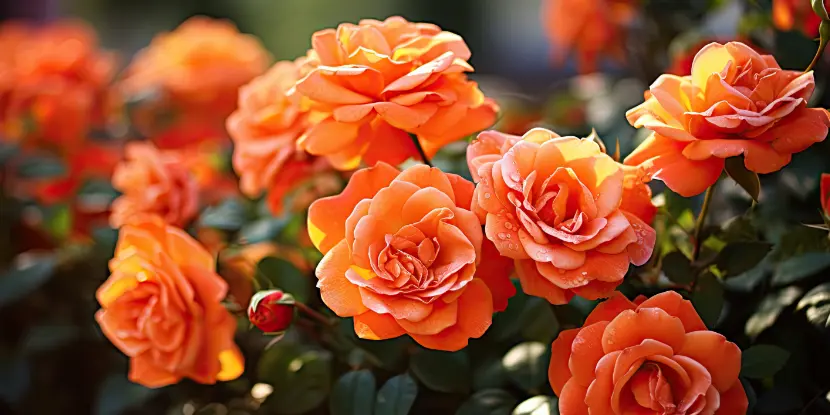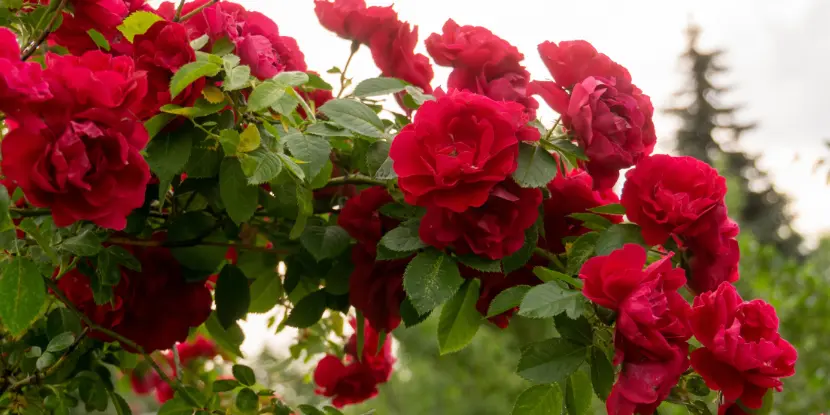Beautiful and fragrant, the rose is the most beloved flower in the US. It’s also our national flower. Roses come in many varieties and grow in all 50 states. Here, we offer descriptions of and care for the most popular types.
Patented Rose
Most new roses are patented. This usually means someone has crossed roses with distinct differences and developed a new rose variety. That person names the rose and secures a plant patent. Until the patent expires, each grower who produces and sells the patented plant pays a royalty on each rose bush.
Standard Rose
Standard roses are unpatented. Many are fine, older varieties that were never patented; others are excellent varieties with expired patents. Roses shouldn’t be selected by their “patented” or “standard” designation, but rather by their quality, health, and adaptability to local conditions.

A hybrid tea rose covered with water droplets.
Hybrid Tea Rose
The Hybrid Tea Rose includes some of the most famous roses, such as Peace, Double Delight, and Mister Lincoln. These long-stemmed roses come in a variety of colors. They’re known for their large, showy blooms and strong fragrance. However, they can be more susceptible to diseases and pests and require regular pruning for optimal growth.
Floribunda Rose
The floribunda rose is a shorter and hardier version of the hybrid tea rose. It produces clusters of smaller blooms in a broader variety of colors than hybrid teas. Floribunda roses are excellent for landscaping and can withstand harsher weather conditions, making them a popular choice for beginner gardeners.

Floribunda roses with orange blooms.
Grandiflora Rose
A cross between hybrid teas and floribundas, the grandiflora rose combines the large blooms of the former with the hearty nature of the latter. These roses are extremely hardy and vigorous. They’ll grow taller than hybrid tea roses and produce large flowers in clusters of two, three, and sometimes four on long, strong stems. With good care, they’ll bloom all spring and summer. With their long stems and rich color variation, they’re ideal for bouquet arrangements.
Climbing Rose
As the name suggests, the climbing roses grow vertically and require support like a trellis or arbor. Varieties include hybrid teas, floribundas, and grandifloras. They’re known for their ability to cover walls, fences, and other structures with an impressive array of colorful blooms. They can grow up to 20 feet tall and bloom all season long.

Floribunda roses blooming in a garden.
Heirloom Rose
Heirloom roses are varieties that have been around for at least 50 years and haven’t been patented. They hold a special place in gardeners’ hearts as they often have unique stories or cultural significance attached to them. Some popular heirloom roses include the Moss Rose, Old Blush, and Cherokee Rose. They may not have the same vibrant colors or large blooms as modern varieties, but they make up for it with their history and charm.
Planting Roses
Roses should be planted so that soil is just under the bud onion (the enlarged knot at the base of stems). Build your rose bed 8 to 10 inches above the surrounding grade or lawn area. An easy and convenient way to do this is to add one bag of cotton burr compost, five bags of topsoil, and one bag of gypsum to existing soil. After planting, mulch the entire bed area with 1 to 2 inches of pine bark mulch. When you plant roses individually, apply the same soil mix described above or use premium rose mix. Also, plant them in graduated mounds, as shown in the diagram below.
Insects & Diseases
Roses are susceptible to pests and diseases. The most common insect pests include aphids, spider mites, and Japanese beetles.
- Aphids are small, greenish insects that suck the sap from the stems and buds, causing distorted growth and a sticky residue. This residue can lead to the growth of sooty mold. A strong jet of water from a hose can dislodge aphids. For severe infestations, consider using insecticidal soap or a systemic insecticide.
- Spider mites, tiny spider-like creatures, cause yellowing leaves. Early detection is key. You can identify them by shaking a leaf over a white sheet of paper; if present, they’ll fall onto the paper and be visible as tiny moving dots. If found, use a miticide for treatment.
- Japanese beetles are metallic green bugs that eat rose foliage and flowers. Handpicking and dropping them into a bucket of soapy water is an effective method for small infestations. For larger problems, use a beetle-specific pesticide.
As for diseases, black spot, powdery mildew, and rose rust are the most common.
- Black spot appears as black spots on leaves that eventually turn yellow and drop off. To treat, remove and destroy affected leaves and spray the plant with a fungicide specially formulated for black spot.
- Powdery mildew forms a white, powdery coating on the leaves and stems. It thrives in warm, humid conditions and can be controlled with a fungicide or a homemade solution of one teaspoon baking soda in one quart of water.
- Rose rust is a fungal disease producing orange patches on the underside of leaves. It requires immediate attention. Remove all affected leaves and treat the rose bush with an appropriate fungicide.
Regular inspection, good air circulation, proper watering, and hygiene practices can prevent most of these problems.
Pruning
Prune your roses in February, cutting back the entire bush to a height of 10 to 12 inches above the ground. Thin out the bush until you leave only three to five main stems. Trim any dead or diseased canes. Make each cut as close as possible to the main stem, leaving no short stubs. Climbing roses should be pruned to only 1/3 of their height yearly. Remember to wear gloves! Spent rose blooms should be removed. Stems should be cut down to the area where the first five-leaf cluster forms. This will keep the rose bush full and compact all year long.
Fertilizing & Watering
Roses bloom on 30-day cycles, approximately. They should be fertilized with prepared rose food after each blooming period. Follow the directions on all packages. A robust and healthy plant will produce its best blossoms during the cooler months of October and November and again in April and May. The rose bed should receive a thorough watering once each week. Avoid over-watering in the evenings or sprinkling the foliage.



